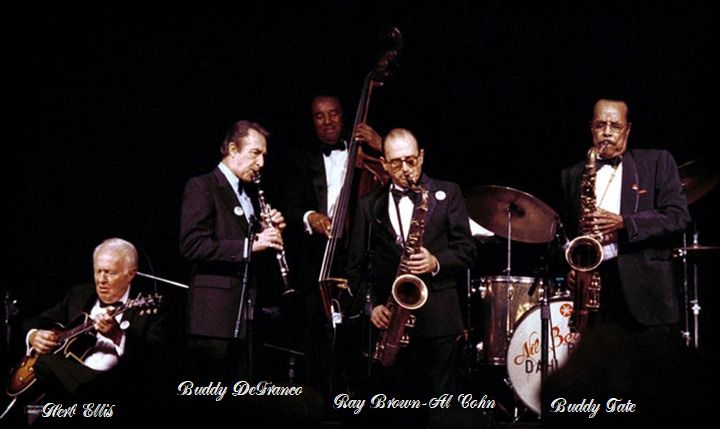
I remained connected to jazz and in two-and-a-half years after being fired from KHFM I had that jazz history course at the University and my weekly show on KUNM. That meant talking to artists who had gigs in Albuquerque, in Santa Fe, or in Denver at Dick Gibson’s Jazz Parties.
Thus encounters there or previously with Gary Burton, Eddie Daniels, Mercer Ellington, Woody Herman, Hank Jones, Wynton Marsalis, Jay McShann, Bud Shank, Buddy Tate (above) and more.
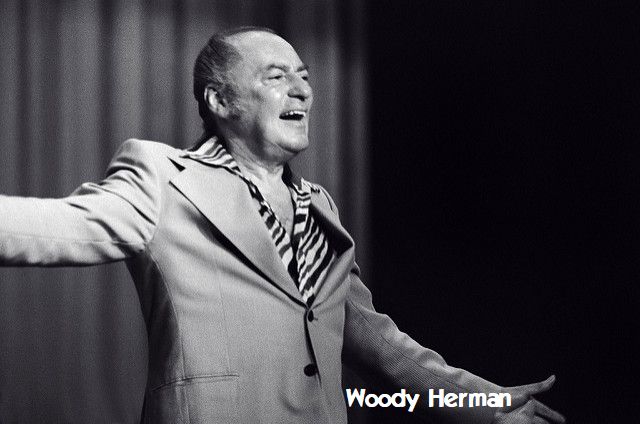
While still at KHFM, I had a chance to talk to Woody Herman who’d brought his big band to play at Santa Fe’s St. John’s College. It was a one-night gig on a chilly March night. Woody was 73 then. And he certainly looked frail and sounded so in our conversation. I’d read stories that reported him in ill health and that he was hanging on because he had major financial problems, owing the IRS millions of dollars due to his long-time bookkeeper’s multiple failings. http://people.com/archive/with-a-1-5-million-debt-to-the-irs-woody-herman-plays-on-to-pay-the-piper-vol-26-no-9/
I brought up the issue about the bookkeeper. Reports had said that Woody didn’t hold it against the man, Abe Turchen, who’d been a close friend. “It’s nothing,” he told me. “I don’t have anything to cry about.” He also mentioned that he was living well, but had to rent his house, one he’d previously owned for 40 years, from the IRS.
Nonetheless, he was still up front and center leading and playing his music, just as Basie and Ellington did in their 70s. “It’s still what I like to do. And I’m too old to retire. But money and fame aren’t really why we’re in music. We love it. It’s a great hobby.”
About what influenced the sound he sought in the band, he mentioned the Jimmy Lunceford Orchestra but most especially the feeling of Duke Ellington’s. Although Ellington always had a specific sound derived from the special styles of soloists whose replacements tended to have similar styles, Herman said he was never looking for that in his own group.
As for his own playing, he cited Coleman Hawkins’s conceptions but continued to feel that he hadn’t yet mastered the clarinet; “I’m still trying to find something easier to play.”
I also asked him about the idea of a Herman ghost band. FYI: the term refers to bands that continue playing essentially the same books and arrangements associated with the leader’s concepts after the leader has died. Actually, it appears that Woody came up with the term, according to his biographer Gene Lees.
By the time Woody and I talked, there were quite a number of such bands, including the Glenn Miller Orchestra (which had been around for decades), plus Basie, Ellington (see below), Tommy Dorsey, Les Brown, and more.
Woody felt that, if someone wanted to front an orchestra in his name and that did something for the new leader, that would be fine.
Woody died about seven months after we met and, shortly before dying, delegated the band leadership to the reed section’s Frank Tiberi who kept the flame alive.
When it comes to what might be called a ghost band, consider the Duke Ellington Orchestra led by Mercer Ellington. I interviewed Mercer. He had taken over the orchestra right after his father’s funeral in 1974.
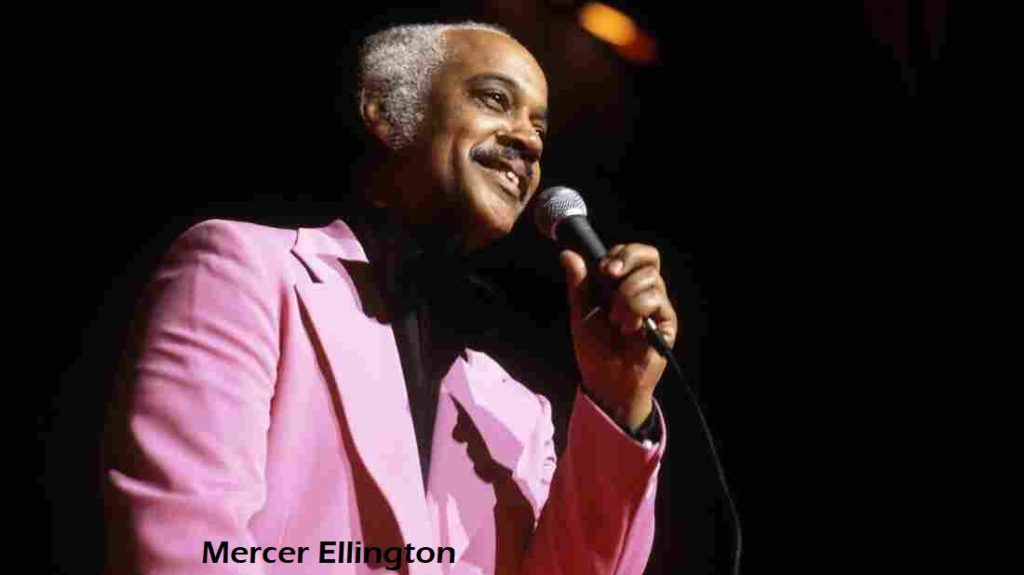
The year we met means that 68-year-old Mercer had already kept it together for 13 years. The Orchestra was sharing the stage for a 1987 performance with the New Mexico Symphony Orchestra. That was also the year in which Mercer and the Orchestra recorded the GRP LP Digital Duke, which garnered the 1988 Grammy for Best Large Jazz Ensemble Album.
I was curious to know how he dealt with inevitable questioning focusing more on his father than himself. “Talking about Ellington,” he answered, “is like talking about myself. I find my voice, mannerisms, even my movements have become like his. He’s taken over my existence.” By the way, Mercer would sometimes talk about Duke as simply “Ellington” or “Dad,” or “Pop.”
Mercer had not only been a member of the family, but of the Orchestra, with 10 years in the trumpet section up until Duke’s death, but also as composer, arranger, and band manager. He was part of the organization.
He had had a separate musical life of his own. From age 20 and for the next 20 years he fronted groups that at times included Dizzy Gillespie, Kenny Dorham, Chico Hamilton, Charles Mingus, and Carmen McRae. But calling another group The Ellington Band didn’t work out too well; it made his father uncomfortable. “He thought it was bad luck.” At times, too, Mercer said, Duke hired people away from him, meaning Mercer attracted major talents, but, since they’d hoped such gigs would be stepping stones to Duke, and they were, it meant that Mercer kept losing the best players.
Sometimes he was also able to get musicians into his father’s orchestra, e.g., the return of Cootie Williams. Cootie had been one of Duke’s biggest stars for 11 years. But in 1940, Benny Goodman hired away Cootie for much more money than Duke could pay. That switch became famed in the jazz world.
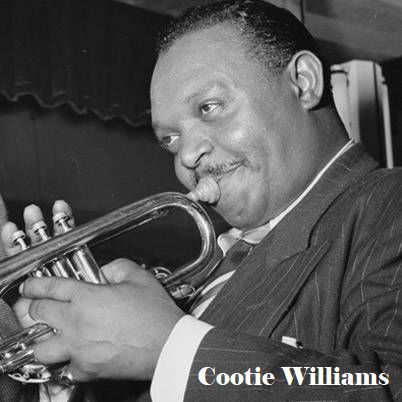
Cootie didn’t stay long with Benny, having left to form his own rather successful group, which, at times, included Charlie Parker, Eddie “Lockjaw” Davis and Bud Powell. Mercer became Cootie’s road manager for a while. By the late ’40s, however, that small orchestra fell apart. Cootie continued to get some gigs and record dates through the 1950s and stayed in touch with Mercer. But by the early ’60s, Williams was reduced to being part of a backup band for comedienne Belle Barth, whose specialty was raw blue humor.
“‘That is ridiculous,’ I told Cootie,” Mercer said. “‘You need Ellington and Ellington needs you. There’s a record date coming up, and I’d like you to be on it.’ I didn’t really know what the hell I was talking about. I didn’t even know if Ellington would welcome him back.” When Cootie showed up for the gig, though, Mercer “reminded” Duke that that was at Duke’s request. Duke didn’t question it, and pointing to a chair in the trumpet section, told Cootie to have a seat. During that session he even gave him a few solos. Cootie stayed with Duke for the next 12 years, up to the time of Duke’s death.
Was his father the only reason that Mercer became a musician? No. “From age eight, I knew that’s what I wanted to do. I was always hanging out with the players from Duke’s earliest group, and when I was on the road with them in 1927, I saw that they were having so much fun. That’s what I wanted to do. So I hung out with them to learn as much as I could.”
Mercer actually started writing and arranging for Duke around the same time that he had started his own group. And during the early ’40s, Mercer came up with several of his best known pieces “Things Ain’t What They Used to Be,” “Moon Mist,” and “Blue Serge.” Certainly “Things” became a regular part of his father’s book. So often, in fact, that record labels often credited it to Duke. “I didn’t care too much as long as they sent me the money.”
As for the origin of “Things,” Mercer devised it in 1942 for a 9 a.m. recording session, after Duke telephoned him at 4 a.m. and told him the band was set to lay down four numbers and he only had three. Evidently Duke knew that Mercer “had been out on the town, staggering. I’d had a lot to drink. And he said ‘I need a fourth side. Write it.’”
Evidently Duke tried to never spoil Mercer and to make sure nothing was easy for his son. “He’d say ‘I gave you an opportunity and you weren’t prepared for it.’ I even raised hell with him because he wouldn’t often play my tunes.” So after that dark-of-night call, “I was determined to do it. I wrote down everything I could think of which sounded like clichés, all the things I could remember in my condition.” Hence the title. The tunes incorporated weren’t what they used to be.
As for “Blue Serge” and “Moon Mist,” they, too, became part of his father’s regular book. The origin of all three was due to Duke’s being unable and unwilling to record anything of his own for about two years. In 1942 there was a strike against all the major record companies by the American Federation of Musicians, due to disagreements about royalty payments. No union musician could make commercial recordings in that strike that went on until 1944. That’s when Duke, being a union member, got Mercer and Billy Strayhorn to do all the writing; they were not AFM members. That was the time, by the way, of Strayhorn masterpieces “Take the A Train,” “Chelsea Bridge,” and “Day Dream.”
I asked Mercer if he continued to write his own pieces and whether the Orchestra would play them. Overall, it seemed, he was constrained to feature his father’s best known pieces, because that’s what audiences came to expect. Nonetheless, he came up with “Carney” for the 1975 LP Continuum on a session which included Cootie plus, in 1989, “Danske Onje (Danish Eyes)” and a suite whose title is the same as Duke’s autobiography, Music is My Mistress, for MusicMasters records. “Yet, whenever I write something that I think is new, I run into something similar to what Ellington wrote before,” he said.
Mercer kept some form of the Orchestra going right up until the year of his death, 1996.
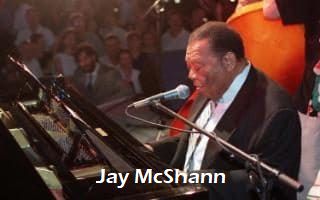
Jay McShann also had led a big band at one time, but when we met that band was a long time before. Charlie Parker has been a member of that group, so inevitably our conversation, like that with Mercer Ellington, dealt with someone who was more of a major part of jazz history than himself. This was at the same 1989 Gibson Jazz Party where I’d also spoken to June Christy (see below).
“The first time I heard Bird was in Kansas City. I was passing by a club one night when I heard him playing. I went up and had a chance to talk with him,” McShann told me. ‘I thought I knew all the cats in town,’ I said to him. ‘Where you from? You sure sound different.’ He said, ‘Oh, I’m from Kansas City, but I’ve been away down in the Ozarks with George Lee’s band. I’ve been woodsheddin’ down there where it’s real quiet, you know, away from where most cats want to be, away from where the happenin’s is. Maybe that’s why I sound different.’ Bird had it together the first time I heard him. That’s why I got him to join my band.”
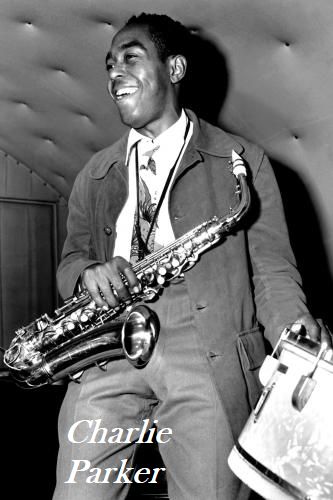
When that happened seems to be a matter of opinion. I’ve read bios that say 1937, 1939, and 1940. In any case, McShann’s group started up in 1937. And clearly Parker stayed with it until 1942. He can be heard soloing in his recording debut on six numbers recorded in Wichita for a 1940 radio broadcast with an eight-member group. “The guys at the station said that they couldn’t afford to pay for more people,” McShann explained.
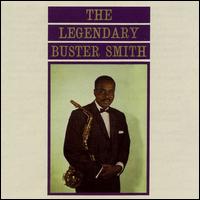
We also talked about the influence on Charlie Parker by legendary alto player Buster Smith, a.k.a. as “Professor.” Evidently Buster mentored Bird in what some jazz writers feel was a sort of father and son relationship. Buster was 16 years older than Parker.
“I remember a time in Kansas City,” McShann pointed out, “when Prof got mad about playing in a club where they were broadcasting. He was supposed to get a raise and they didn’t give it to him. Anyway, I was listenin’ one night and thought that ole Prof sure sounded good. The next day I ran into him and told him so. ‘That wasn’t me; that was Bird,’ he said.” He’d asked Bird to sit in for him.
McShann’s 11-member band was swinging in K.C. around the same time as Basie’s. It must have sounded special. You can hear how because it got recording dates with Decca Records’ Dave Kapp in 1941. The first session was four tunes, Parker soloing. “We tried to record a lot of our original stuff, but Kapp said it was too modern. ‘Listen,’ he said, ‘I can’t sell that. It’s good; but I need something I can sell.’”
“We was very disappointed, ’cause we wanted to record what we wanted to play. So Kapp says, ‘Can you play a blues?’ We said we could. ‘OK. Play me a blues.’ After we did that, he said, ‘Play me a boogie-woogie.’ We did that. Then he said, ‘Play me one more blues and I’ll take one of them funny tunes.’ That was ‘Swingmatism.”
The band broke up in 1944 when Jay was drafted into the U.S. Army. But he never had another; the band business was not thriving anymore, although he fronted some pick-up ones as heard in a reunion with Jimmy Witherspoon in 1958’s Goin’ to Kansas City Blues.
Kansas City was where all the happenings were for Jay. He settled there in 1936 after gigs all over the Midwest and Southwest. And went back after he got out of the Army. But his career got off the ground in Tulsa. “At first I couldn’t get a job anywhere. But I heard a band rehearsin’ in a club and I listened real well. I didn’t hear a piano. So I went up there. And I said to the leader ‘Do y’all still need a piano player?’ So he told me to take a seat and play something. They put music in front of me. And I started playin,’ but I couldn’t read a note as big as a house. They thought I was readin’, but I was just playing the same music I’d heard them playing. So then the leader said, you know, ‘Take off on something.’ I sure could do that. He listened and then told me I had a job cause he wanted a guy who can read and play and make up something.”
After the Army, McShann was pretty much out of the national picture, except for a few record dates. He stayed in K.C. because he had young kids in school. “Maybe goin’ not further than 300 to 600 miles.” But he started coming back in the late ’60s, not just as a pianist but also as a singer. “I started singing because I didn’t have any singer with me, you know, and people wanted to hear one.”
When we met in 1989, at age 73 he spoke about how he’d been flourishing. “I play more often these days and I enjoy it just as much as I ever did. But I sure do miss havin’ a big band. I got such a great kick outa it. I loved that sound. Specially when I had so many great cats in it.”
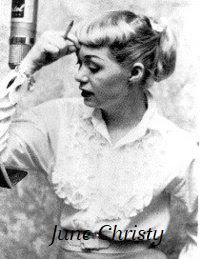
One wonderful surprise was also a chance to interview singer June Christy. I’d always loved her smoky, sweet sound given her records with the Stan Kenton Orchestra and thereafter.
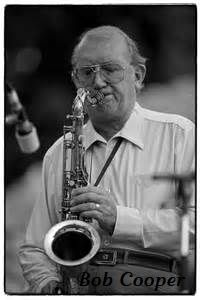
At a 1989 Gibson Party, when talking to composer/arranger Johnny Mandel, he told me that Christy was attending and directed me to Christy’s husband tenor saxophonist Bob Cooper. Christy and Coop had been married since the late 1940s.
The little lady looked old, although, as I later learned, she was only 63 when we met. In fact, I just recently discovered that she died the next year. And that she had had problems with alcoholism.
Speaking, she still retained that sweet, smoky sound while seeming full of happiness, and Coop standing nearby looking on lovingly.
About her sound, she agreed that Kenton favored such a quality, from Anita O’Day before her and Chris Connor thereafter. And that that may have been one reason Kenton liked her after he’d heard a demo disc she’d brought to him at age 17-and-a-half when the band was playing in Chicago.
Although she’d loved those years with Kenton, she said, the constant traveling, the one-night stands, caused her to decide to retire more than once, even though she loved the feeling of being part of a family with all the guys on the buses. “I can’t tell you how many times I retired,” she laughed. But she’d go back to touring, for example, “because the house needed new drapes.”
Speaking of recording with Kenton, I reminded her of one unusual recording from 1947 (age 22), “This is My Theme,” a Pete Rugolo score setting a poem, I’ve just learned, by Audrey Lacey. Conceptually it was very much a part of Kenton’s “Innovations” concepts, modernism in orchestrations much removed from dance music and pop. Not usually the kind of thing in which Christy took part.
In this case, Christy mostly narrated, dramatizing such phrases as “…carrying me to one high screaming peak, it drives me on…crystal sheets of hysterical laughter rising to a maddening pitch.” Christy told me that she hated that piece and eventually told Kenton. So he promised her that she’d “never have to sing it in front of an audience again.” For the next performance, he had her delivering the piece from a backstage microphone.
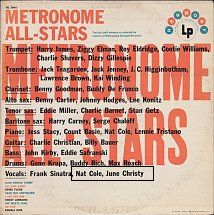
Regarding her records, we spoke about her being one of the Metronome All-Stars in 1946 when she and Nat Cole performed together. The jazz magazine’s readers voted for their favorites each year from 1931 to 1961. Then the musicians were collected into a studio to record one or two tracks together.
Evidently not all the musicians chosen showed up for the session on time, so, according to Christy, Nat Cole told her that they’d have to just wing their duo with the other performers. “That frightened me. I wasn’t used to being that spontaneous. I didn’t know what to do. But I’d always loved Nat’s singing, so I was happy to sing whatever he suggested.” He suggested a blues (“Gee, but I’m lonesome/Feel like I’m wanna cry (repeat) cause the man I loved has done gone and said goodbye.” It worked. After she took one chorus and Nat took one, each of the other All-Stars got solos: Charlie Shavers, Lawrence Brown, Johnny Hodges, etc.
I never aired the interviews with Christy or McShann, even though I had that jazz show on KUNM at the University of New Mexico. I never got around to editing them back then, but always thought I’d broadcast them some time in the future. I had chances to do so thereafter in Milwaukee, Pittsburgh, and Omaha. Nope.
More jazz
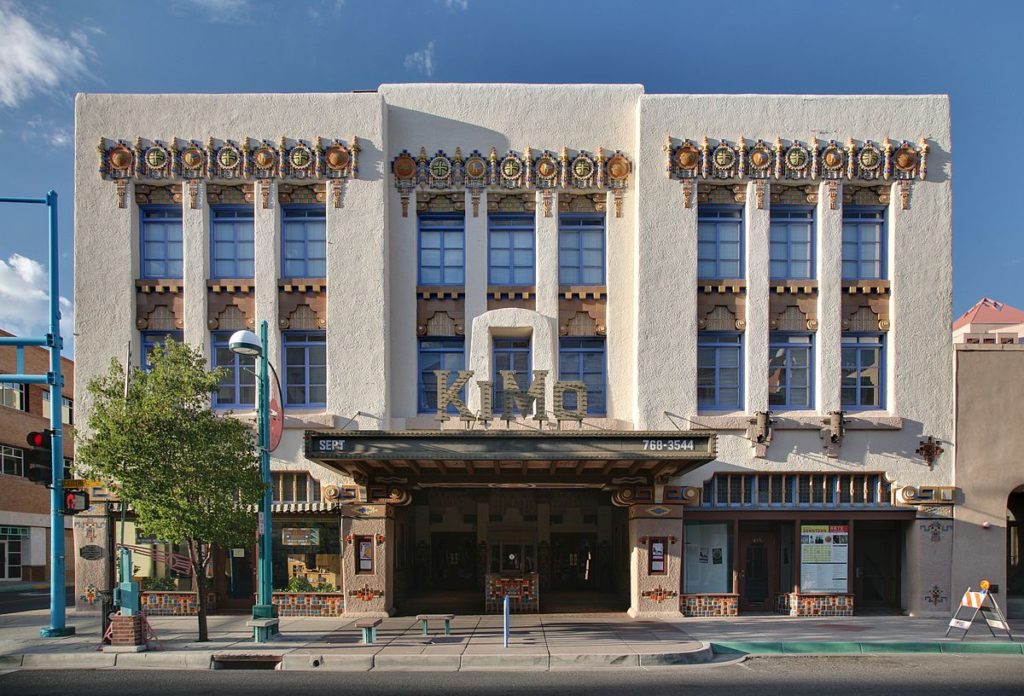
The Phil Woods Quintet performed in Albuquerque at the KiMo Theatre in 1984. The wonderful Pueblo Deco building from 1927 had been restored in 1977 following a fire and disrepair that went with the disuse of downtown. By the time we arrived in New Mexico, it and downtown were picking up again, and the KiMo had become a major venue for live on stage performances. That same year the newly formed New Mexico Repertory Theater made the KiMo its home (more below).
Two things I remember most from the Woods performance. One was seeing trumpet player Tom Harrell for the first time. His physical movements looked strange, as if he was not entirely there. No signs of enjoyment, no sense of his body responding to the rhythms around him. I later learned that he had paranoid schizophrenia and was on drugs to control the problem. The other thing that struck me was Woods, after naming the first piece, turning to the audience to tell us that he always believed in identifying the music and that an informed audience was the best audience.
That statement resonated with me a few years later, in the late ’80s during a Miles Davis gig, and two by the Basie Orchestra, the second one with Dizzy Gillespie and Billy Eckstine. The first two events were at Popejoy Hall on the University of New Mexico campus, the biggest venue in town, where most New Mexico Symphony Orchestra concerts took place, plus those of touring ballet, opera, and Broadway-centered shows.
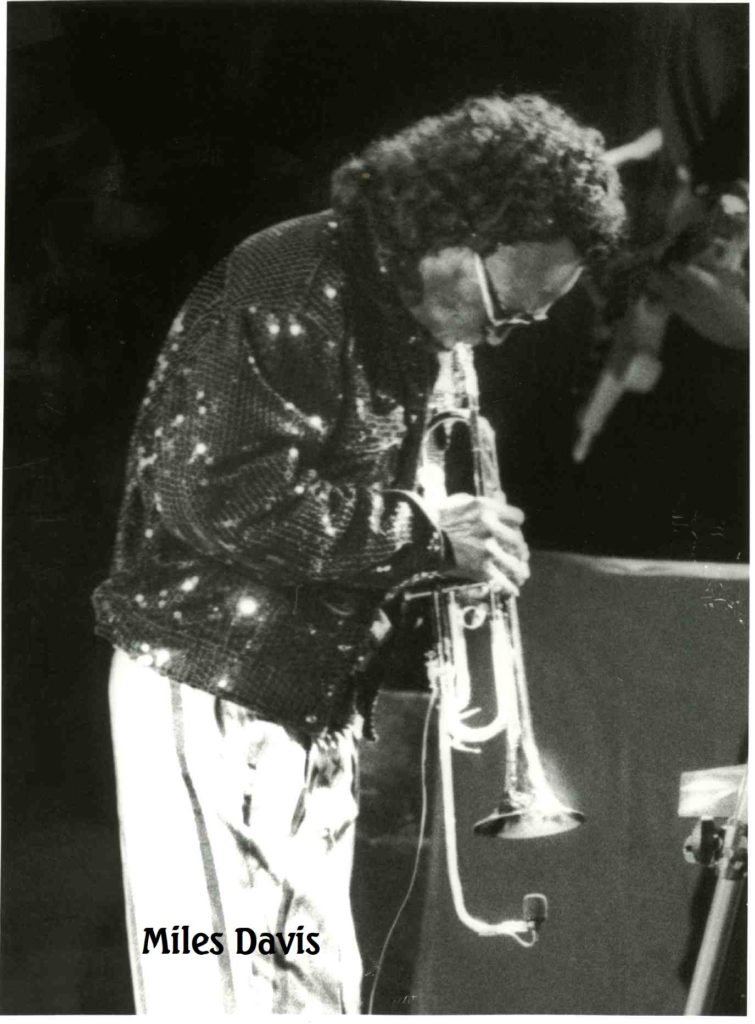
Miles didn’t speak to the audience, not only not identifying the music but also not the performers with him following their solos. Consistent with Miles’s famed disdain for making nice. Every so often he did hold up one of several large signs on which, each time, one word was written. One said “Foley.” I had no idea what that meant. Later I learned that that was the name of one of the guitarists. And, somewhere around that time, I also learned that Kenny Garrett was the alto player, and Marcus Miller was playing electric bass.
The physical activity on stage seemed as indifferent as the lack of communication. This Chicago Tribune description about a 1991 performance, i.e., not that much later, sounds the same: “Backed by a band that owes more to funk and rock than jazz or blues, Davis roams the stage, tossing in a melodic fragment here, a background phrase there. At one moment he huddles with guitarist Joseph Foley MacCreary, trading musical phrases as they walk the stage together; at another, Davis ambles over to a bank of electronic keyboards, hitting an appropriate chord now and then. In solo passages, he generally turns his back to the audience, hunches his shoulders over and points his horn to the ground.”
The Kiva Auditorium in Albuquerque resounded with HIGH VOLUME. So much so, that, when I reviewed the event for Zounds, a weekly newspaper, I wrote the whole thing IN CAPS. I later acquired a CD of a 1989 session from Warner Brothers called Amandla with Foley, identified by only one name, Garrett, and Miller. It sounded very similar to what I’d heard that evening. I like it. At lower volume.
The Basie Orchestra was led by Frank Foster. Both times he rarely used the microphone to name the tunes or the soloists. When he did so, he did it when the applause was at its strongest, thereby uselessly. During that first gig, I went down a back hall at intermission to try to speak with him about that. Encountering him, I said how dismaying it was to not hear and understand him, asking him to delay the information until the applause died down. In a pissed-off way, he said, “We don’t have time to wait that long.” Whatever that meant.
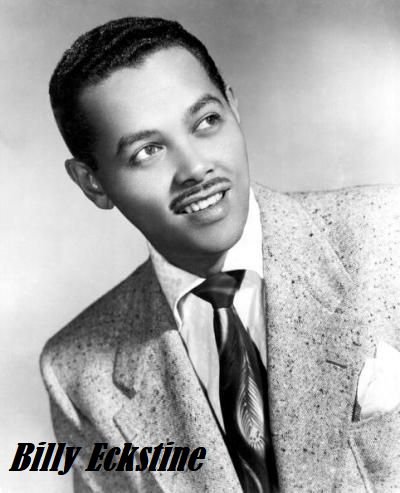
For the second appearance a later year, at the Kiva Auditorium, “Dizzy and Mr. B. Salute the Count,” Diz was already in his ’70s and Billy in his mid-’70s. You’ve got to hand it to them for being up there. Especially when their ages meant that they were no longer in their primes and that they would have had a tough time living up to their reputations.
Here are parts of what I wrote in a review for Zounds:
Those who hope for continued golden moments in the name of the past may be trying too hard to hold on to their glittering recollections. Am I? By expecting them to be better than they were at this concert? Sure, if this was supposed to be an evening of good music.
Hey! This is the “re” decade: recycling, reliving, revisiting, the 1980s wrapping up nostalgia packages; this show was right on the money for such a marketing product.
When the band lit into Mercer Ellington’s “Things Ain’t What They Used to Be,” the focus of the rest of the event was symbolically foretold. It was clear that crowd-pleasing was the game as the spotlight fell for one of many times on drummer Duffy Jackson, a head-nodding, arms-flailing visual spectacle, showing how fast he could play.
There were other displays of what the band could do, with a few more solos bordering on interesting with a hell of a lot more of Duffy. They crowd dug that. Lucky them.
Foster still lacked the skills as an m.c., consistently naming the soloists while applause drowned out his every word. Then he trotted out that old cliché “little lady” to present singer Carmen Bradford. Little she ain’t, daddy. She sang rather well at times, particularly in “See See Rider,” which lifted the band above solid and dependable gloss into a few moments of drive and fire.
Then it was Diz’s turn. Foster went off the stand leaving the band to back up Diz in whatever way it could without an obvious leader. Diz’s playing was more uneven than good. The notes flurried with as much skill as ever, but the tone was often strained and the pitch not much on keel. He spotlighted his own excellent arrangements of “Round Midnight” and “Manteca” that he’d arranged at one time for Count. That was as far as the title “Salute to Count” went for him. No verbal statements of tribute. There Diz soloed with taste. He didn’t hold back. He gave as good as he could. That should have made the real music lovers feel that they’d gotten their money’s worth.
A standing ovation, of course. Why not? Probably as much for the fact that he was still alive and playing as for what he’d just done.
After intermission the band, Foster up front, fielded a few more pop-ups, such as “April in Paris” (“one more time,” for chrissakes. How many times do we need it?) along with other mementos.
Then came the Eckstine set. “Where the hell are we?” he asked, grabbing the microphone. Feeble laughter from the band which may have equally wondered the same. They were out on the road propping up memory. This time, a frail version of The Act. Straining to hold on to the voice, wandering up and down the stage with as much presence as a sad marionette in the hands of an apprentice. This was a legend of great popularity built on records, and off-stage unseen appeal. Wobbly knees now. An inadequate smattering of patter and a story to tell about Duke arriving in heaven, which got befuddled in telling and told a story more about the teller.
To Mr. B’s credit though, he didn’t do too much memory-land stuff, trying to remind us of his old hits. His choice of material and the arrangements played by the band with an unidentified leader other than Foster were often tasteful. Too bad that Eckstine is no longer able to sing with quality equal to the material chosen. After about six such numbers, gathering diminishing polite applause, some people in the audience began drifting out.
There will be more good performances, I’m sure, by the Basie band. Maybe even at a time when it’s mostly a backup group in such road shows. Diz will still have a few glowing moments, I’m certain, but probably the best are now behind him. Ahead of him and Mr. B. is more of the road. Too bad that they need to go out on it, that punishing jostle, an astigmatic jump-off vision of America. Time out of joint, their own joints shaky and not what they once were, any more than are mine, any more than for many others there at the Kiva in search of an illusion of time standing still.
There were also several Santa Fe Jazz parties, similar in concept to Dick Gibson’s at Denver. These were produced by Bumble Bee Bob Weil. He featured a lot of younger greats, such as Howard Alden, Dan Barrett, Eddie Daniels, Ken Peplowski, and Warren Vaché. All of whom I interviewed and whose interviews I’ve never since broadcast, alas.